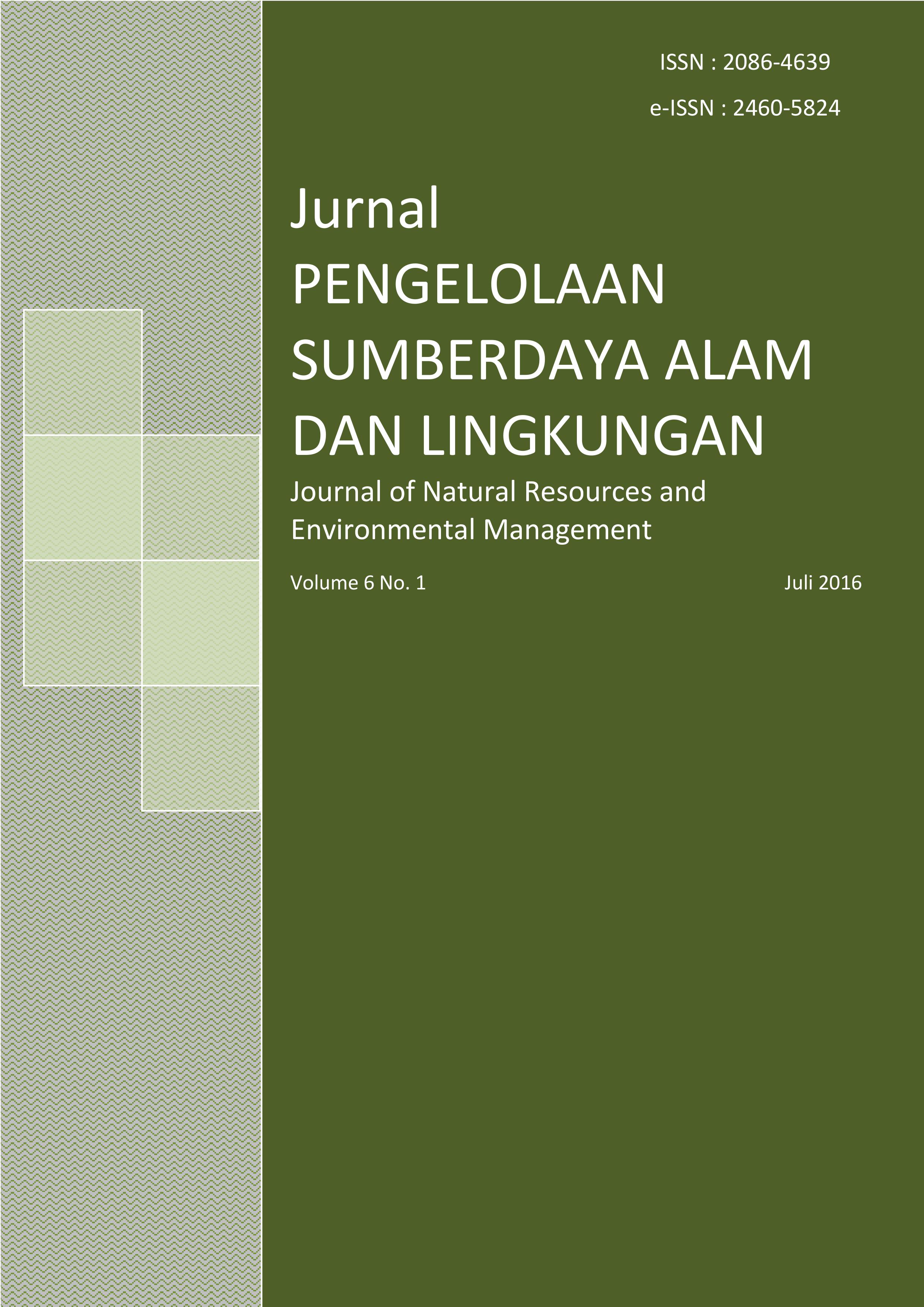BIOREMEDIASI TANAH BERTEKSTUR KLEI TERKONTAMINASI MINYAK BUMI: APLIKASI TEKNIK BIOPILE DENGAN PENAMBAHAN PASIR
Abstract
References
Baptista, S. J., M. C. Cammarota, Dias, 2005. Production of CO2 in crude oil bioremediation in clay soil. Braz Arch Biol Technol. 48, pp. 249-255.
Black, G. R., K. H. Hartge, 1986. Bulk Density and Particle Density. Methods of Soil Analysis. Part 1. Physical and Mineralogical Methods. 2nd Edition. American Society of Agronomy, Madison WI.
Brady, N. C. 1984. The Nature and Properties of Soils. 9nd Edition. Macmillan, New York .
Cappucino, J. G., N. Sherman, 1987. Microbiology: A Laboratory Manual. Benjamin Cummings, California.
Charlena. 2010. Bioremediasi tanah tercemar limbah minyak berat menggunakan konsorsium bakteri . Disertasi. Institut Pertanian Bogor, Bogor.
Charlena, Z. M. Alim, I. Anas, Y. Setiadi, M. Yani, 2010. Produksi gas karbon dioksida selama proses bioremediasi limbah heavy oil dengan teknik landfarming. Chem. Prog. 3(1), pp. 1-5.
Chokshi, B. G., Y. M. Nelson, 2003. Optimization of highstrength hydrocarbon biodegradation using respirometry. Dalam: Magar VS, Kelley ME, editor. In Situ and On-Site Bioremediation. Proc. Seventh Intern In Situ and On-Site Bioremediation Symp. pp. 1-10. Battle Pr, Orlando.
Cookson, J. T., 1995. Bioremediation Engineering: Design and Aplication. McGraw-Hill, New York.
Cong, L. T. N., A. Mikolasch, H. P. Klenk, F. Schauer, 2009. Degradation of the multiple branched alkane 2,6,10,14tetramethyl-pentadecane (pristane) in rhodococcus ruber and mycobacterium neoaurum. Intern Biodeterioration & Biodegradation. 63, PP. 201–207.
Danielson, R.E., P. L. Sutherland, 1986. Pore Size Distribution. Methods of Soil Analysis. Part 1. Physical and Mineralogical Methods. 2nd Edition. American Society of Agronomy, Madison WI.
Das, N., P. Chandran, 2011. Microbial degradation of petroleum hydrocarbon contaminants: an overview. Biotech Res Intern. 2(1), PP 1-13. doi:10.4061/2011/941810.
Dhote, M., A. Juwarkar, A. Kumar, G.S. Kanade, T. Chakrabarti, 2009. Biodegradation of chrysene by the bacterial strains isolated from oily sludge. World J Microbiol Biotechnol. 26(2), pp. 29–335.
Eaton, A. D., L. S. Aesceri, E. W. Rice, A. E. Greenberg, 2005. Standar Methods for the Examination of Water and Wastewater. American Public Health Association, Washington DC.
Gee, G. W, J. W. Bauder, 1986. Particle Size Analysis. Methods of Soil Analysis. Part 1. Physical and Mineralogical Methods. 2nd Edition. American Society of Agronomy, Madison WI.
Hwang, E. Y., J. S. Park, J. D. Kim, W. Namkoong, 2006. Effects of aeration mode on the composting of diesel contaminated soil. J Ind Eng Chem. 12 (5), pp. 694-701.
Jorgensen, K. S., J. Puustinen, A. M. Sourtti, 2000. Bioremediation of petroleum hydrocarbon-contam-inated soil by composting in biopiles. Env Poll. 107, pp. 245-254.
Juhasz, A.L., N. Waller, C. Lease, R. Bentham R. Stewart, 2005. Pilot scale bioremediation of creosote-contaminated soil-efficacy of enhanced natural attenuation and bioaugmentation strategies. Biorem J. 9 (3-4), pp. 141-157. doi: 10.1080/10889860 600572772.
Kamnikar, B. 1992. Bioremediation of contaminated soil. Poll Eng. 24(21), pp. 50-52.
[Kemen LH] Kementrian Negara Lingkungan Hidup, 2003. Keputusan Menteri Lingkungan Hidup No 128 tahun 2003 Tentang Tatacara dan Persyaratan Teknis Pengolahan Limbah Minyak Bumi dan Tanah Terkontaminasi Limbah Minyak Bumi Secara Biologis. Kementrian Negara Lingkungan Hidup, Jakarta.
Komarawidjaja, W., E. Lysiastuti, 2009. status konsorsium mikroba lokal pendegradasi minyak. J Teknol Lingk. 10(3), pp. 347-354.
Kratzke, R., W. Major, F.V. Fahnestock, G. Wickramanayake, 1998. Biopile Design, Operation and Maintenance Handbook for Treating Hydrocarbon Contaminated Soils. Battelle Pr, Ohio.
Kuhlmeier, P. D., 1994. Biodegradation of Organic Pol-lutants in Soil. In: DL Wise, DJ Trantolo, editor. Process Engineering for Pollution Control and Waste Minimization. Marcel Dekker, New York .
Li, L., C.J. Cunningham, V. Pas, J.C. Philp, D. A. Barry, P. Anderson, 2004. Field trial of a new aeration system for enhancing biodegradation in a biopile. Waste Manag. 24, pp. 17137.
Nugroho, Y. 2009. Analisis sifat fisik-kimia dan kesuburan tanah pada lokasi rencana hutan tanaman industri pt prima multibuana. Hutan Tropis Borneo 10 (27), pp 222-229.
Olsen, S.R., C.V. Cole, F.S. Watanabe, L.A. Dean, 1954. Estimation of Available P in Soils by Extraction with Sodium Bicarbonate. USDA Cir. No 939.
Priyanto, B. 2012. Toleransi lima jenis rumput terhadap minyak dan kapasitas degradasinya dalam sistem fitoremediasi. J Teknol Lingk. 13 (2), pp. 141-149.
Rachman, L. M, E. D. Wahjunie, K.R. Brata, W. Purwakusuma, K. Murtilaksono, 2013. Fisika Tanah Dasar. DITSL-IPB, Bogor.
Sharma, S. 2012. Bioremediation: features, strategies and applications. Asian J of Pharm Life Sci. 2 (2), pp. 202-21.
Sopiah, N., Arifudin, 2012. Uji coba kinerja bakteri karbonoklastik pada tanah tercemar minyak bumi dengan teknik landfarming. J Teknol Lingk. 13 (2), pp. 131-140.
[USEPA] United States Environmental Protection Agency. 2004. Chapter IV (Biopile) of OUST's publication: How to Evaluate Alternative Cleanup Technologies for Underground Storage Tank Sites: A Guide for Corrective Action Plan Reviewers, USEPA, Washington DC.
Vidali, M. 2001. Bioremediation. an overview. Pure Applied Chem. 73 (7) pp. 63-172.
Zam, S. I., 2010. Optimasi konsentrasi inokulum, rasio c:n:p dan ph pada proses bioremediasi limbah pengilangan minyak bumi menggunakan kultur campuran. El-Hayah 1 (2), pp. 2334.
Authors
Authors who publish with this journal agree to the following terms:
- Authors retain copyright and grant the journal right of first publication with the work simultaneously licensed under a Creative Commons Attribution License that allows others to share the work with an acknowledgement of the work's authorship and initial publication in this journal.
- Authors are able to enter into separate, additional contractual arrangements for the non-exclusive distribution of the journal's published version of the work (e.g., post it to an institutional repository or publish it in a book), with an acknowledgement of its initial publication in this journal.
- Authors are permitted and encouraged to post their work online (e.g., in institutional repositories or on their website) prior to and during the submission process, as it can lead to productive exchanges, as well as earlier and greater citation of published work (See The Effect of Open Access).






